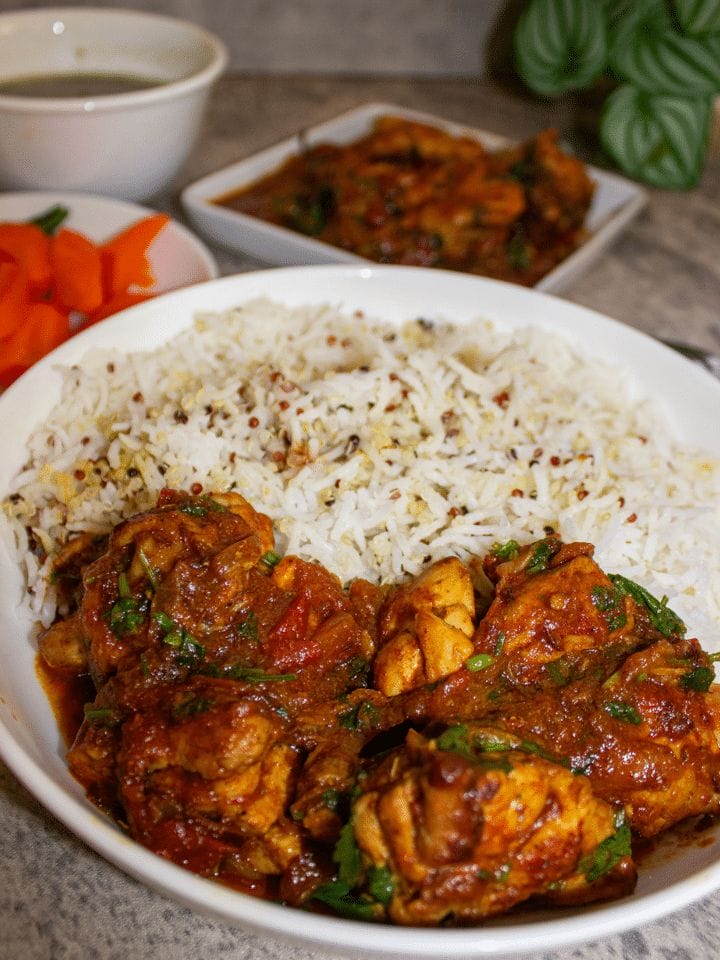
If you’re a curry lover like me, you know that tomatoes are a key ingredient in many recipes. They add a tangy flavor and vibrant color that’s hard to resist.
I love making curries with tomatoes – they’re a must-have ingredient for me, whether chicken, pork, or potato curry.
However, I’ve made curries without them, which still turned out delicious.
There are plenty of substitutes for tomato in curry.
Whether it’s due to allergies or simply not liking the taste, there are several reasons why someone may want to find a substitute for tomato in their curry.
This blog post will explore some of the best tomato alternatives and how to use them in your next curry dish.

Dairy-Based Substitutes
1. Yogurt

Yogurt is a commonly used dairy-based alternative to tomato in curry dishes. It has a distinct tangy taste and a creamy texture that can enhance the overall flavor profile of the dish.
You can add yogurt towards the end of the cooking process to use yogurt as a substitute.
Yogurt can also be used as a marinade for meat or vegetables, infusing them with its unique flavor before cooking.
If you’re not a yogurt fan, here are the substitutes you can use to add a creamy texture to your curry.
2. Cream
Cream is another dairy-based substitute that can be used in place of tomato in curry. It has a rich and creamy texture.
To use cream as a substitute, add it towards the end of cooking and stir well. Be careful not to let the cream boil, as it may curdle.
3. Coconut Milk

Coconut milk is a widely used dairy-free replacement for tomatoes in curry dishes. It has a unique, nutty, and sweet flavor that can add a tropical flair to the dish.
To add coconut milk as a substitute, it can be added towards the end of the cooking process or used as a base for the curry sauce.
However, using dairy-based substitutes may affect the flavor and texture of the dish. Therefore, it’s essential to experiment with different types and quantities of dairy to find the perfect substitute that suits your curry recipe.
Other Substitutes
4. Tamarind
Tamarind is a popular ingredient in many Asian and African cuisines. It is a sour fruit, which makes it perfect for adding acidity to dishes. It is often used as a substitute for tomato in curry.

It can be used in various forms, such as tamarind paste, concentrate, and tamarind pulp.
Tamarind paste is the most commonly used form in cooking, made by soaking tamarind pulp in warm water and straining it to remove the seeds and fibers.
Tamarind concentrate is a more concentrated form, often used in commercial food production, while tamarind pulp is the raw form used in some traditional recipes.
Here are some tips for using tamarind as a substitute for tomato in curry:
- Use tamarind paste or concentrate instead of tomato paste or puree.
- It’s essential to start with a small amount and adjust it based on your taste preferences. This will ensure that the tamarind’s tartness doesn’t overpower the other flavors in your recipe. So, go ahead and experiment with different amounts.
- Use other ingredients, such as onions, garlic, and ginger, to add flavor to the dish.
5. Tomato Sauce

Tomato sauce is a versatile and flavorful substitute for fresh tomatoes in curries.
It’s an excellent option for those who don’t have access to fresh tomatoes or are looking for a quick and easy alternative.
The sauce is made from cooked and pureed tomatoes, which gives it a similar texture to fresh tomatoes.
It also adds a rich and tangy flavor to the curry, making it a perfect addition to any recipe.
6. Tomato Paste
The other substitute is tomato paste. It is a concentrated paste made from cooked and strained tomatoes, reduced to a thick, rich paste.
When using tomato paste in curries, it’s important to keep in mind that it has a strong and concentrated flavor.
Diluting it with water before adding it to your curry is a great way to ensure that it’s not too overpowering and to distribute the flavor evenly throughout the dish.
One thing I love about using tomato paste in curries is that it’s such a cost-effective option. You don’t need to use a lot of it to get that deep, rich flavor that we all love in a good curry.
One tablespoon of tomato paste for every cup of liquid in your recipe should do the trick!
Just be mindful of the concentration and salt content, and adjust the seasoning accordingly.
Conclusion
Whether you want to add more flavor to your dish or need an alternative due to allergies or personal preferences, these options can help you achieve the same texture and taste as tomatoes.
The possibilities are endless, from tangy tamarind to creamy cream. So, the next time you make a curry and find yourself without tomatoes, don’t panic!
Experiment with these substitutes and discover new flavors and textures for your curries.
Curry Recipes
Here are a few curry recipes that you might enjoy – some with tomatoes and some without!




